A Prelude to a Swing
Tom Corrigan, RKC
April 28, 2006 12:00 PM
There is no argument that the swing is the fundamental move of kettlebell lifting. It must be learned before moving on to the clean, snatch and other important lifts. So you need to learn (and teach) the swing first, right? Well, I used to believe so, but now I think it's better to learn a three-move sequence before moving to the swing.
These moves build upon each other, teaching and reinforcing good habits. As each one is learned, it's just a small, easily mastered step to the next one, because only one change is made from the previous move. The sequence not only builds confidence, but enhances safety. From my experience, about a third of trainees will learn the swing quickly, with only a pointer or two. Another third may have a flaw, which will require a remedial drill. The lowest third will have multiple problems, requiring immediate attention and correction.
You'll have to catch them quickly, before they do too many flawed repetitions, which will take hundreds of correct reps to learn the proper technique. My sequence is meant to drastically reduce the remediation needed. The trainee will not move onto the second move until the first is mastered.
The first move is the two-handed deadlift. Through this move you learn to fold at the hips, keep your back flat or slightly arched, correct foot spacing and knee alignment. You learn to keep your arms and wrist straight, to use leg and hip drive, and then how to return the bell safely to the ground. Every skill will transfer to their swing. The only real changes will be the tempo and the movement of the arms. Everything else should be good to go.
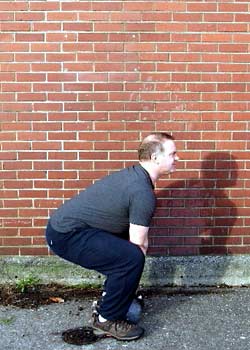
Start position - hips loaded, back flat, eyes forward
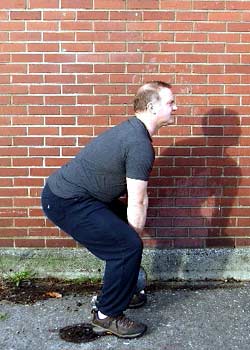
Beginning to extend the hips - back still flat.
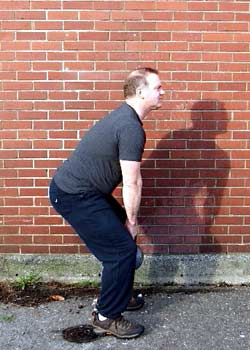
Note the path of the KB is straight up.
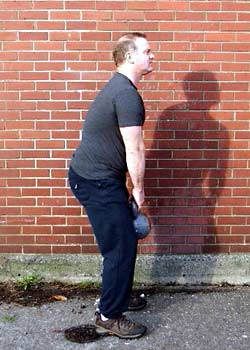
KB still on a vertical path near lockout.
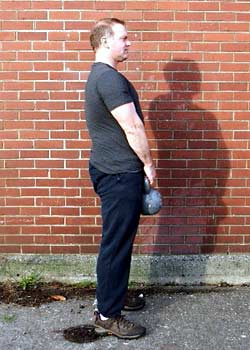
Full Lockout - hips fully extended and body tall.
The advantage of starting with the deadlift is that it is a slow, controlled move. Mistakes can be caught quickly. To some this may seem too basic, but since most people's weight training experience today comes from health club machines, I think it best to start with this most fundamental of all lifts.
Another thing you can do is control the tempo by counting. Using a four-count, the bell is lifted and at count 1 it is mid-shin, by 2 it's at the knees, by 3 it's at mid-thigh, and at 4 the hips are locked-out with a squeeze. Then the sequence is reversed. By doing it this tempo, it will be easy to "groove" this muscular motor pattern. You can start by doing sets of singles, standing up and resetting between each rep. Then the trainee can do sets of three to five, lowering the bell to about four inches off the ground instead of putting on the ground.
The second move is the "Rhythmic Deadlift" because the tempo is the key. Everything stays the same, except now the lifting will be done on a quicker count. The trainee will only have to focus on speeding up the tempo, and keeping a steady pace. There are no changes to form or technique at all.
This is a good time to introduce a simple breathing pattern. I just have them sniff in through their nose as they lower, and let a little air out as they lock-out. They can also count at the top, in a quick, coughing-like manner. It's fine to start with sets of five to start with, before moving to sets of ten. Most people have been trained to lift slow and smooth at their health clubs, so this ballistic training will be new to them.
They will need to build confidence in their bracing and tensioning skills. Multiple sets of the Rhythmic Deadlift will do this. The easiest way to start is with a two-count. At "1", the bell is at the knees, and at "2" it is locked-out. When they can do the two-count well, keeping good form and rhythm, they can then do a one-count. This fast pace will mimic the quickness and snap they need to do the swing.
The third and final move is the "Half-Swing", in which you swing the bell to your waist level. Now I know that this is just a swing done to a low level, but I decided to name it for a few reasons. By naming it, the move now has distinct parameters. If you swing it to your head level, you have done it wrong. Doing it low will be safer to control, and it will be easier to keep a steady, metronome-like rhythm. The chance of being pulled forward, or generating more force than you can handle is diminished. In addition, the half-swing reinforces the idea that the swing is about the hip-snap and straight arms, not just about swinging it as high as you can.

Hike Position: Flat back, Eyes forward, Hips loaded
note the KB is high between the legs.
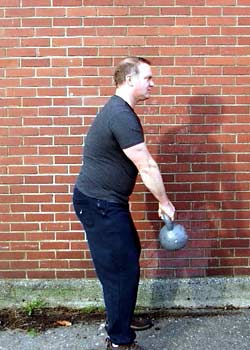
As the hips begin to extend note the arms stay "connected" to the body.
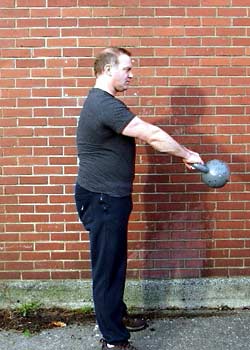
Top position: Hips fully extended, body tall -
arms still "connected" to the body.The way I usually teach the Half-Swing is by having the trainee do two Rhythmic Deadlifts, and then on the third rep, they pull the bell up, and after lock-out, they push the bell back behind their thighs as they descend. I tell them that their wrists should be about mid-thigh level on this back-swing. Another cue is to tell them to "hike" the KB like a football. When they stand up, they just let the bell swing out in front of them, with their hands going to waist level.
Be sure that they know that this point is now the lock-out, and so they should tighten up their mid-section and glutes at the top, just like when they performed the deadlift. You can have a partner stand to the side, making an L pattern. They stick out their arm and put their open palm facing down at waist level where the swing ends. The bell will slap the palm at the top of the rep, reinforcing the tightening at the top. It also helps them to focus and it prevents them from swinging too high.
Try this sequence the next time you show a beginner the swing. If they are talented, they'll pick it up quickly, and you'll know they have got the principles of the swing down. If they struggle a bit, you'll be able to spot and fix their problems quickly, and you won't have to worry about them swinging too high or too fast and hurting themselves or anyone else within range of their kettlebell.
Fireman Tom Corrigan, RKC teaches kettlebells in Seattle. E-mail him at kbfiremantom@yahoo.com.
Back